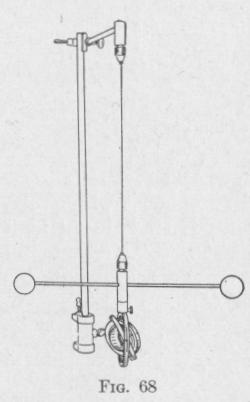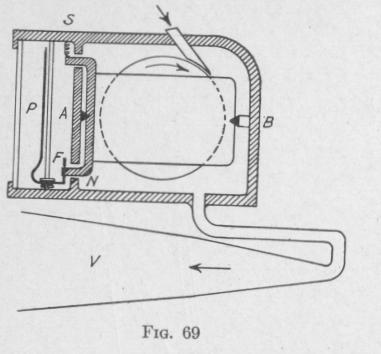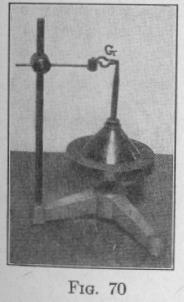84 MOTION OF A SPINNING BODY
Experiment. - Figure 68 represents a gyroscope attached to a system capable of angular oscillation about a vertical axis. The ring carrying the gyro is incapable of rotation about a vertical axis independently of the outer frame. Set the gyro spinning and set the whole system into angular oscillation about the vertical axis. Observe that the spin-axle sets itself parallel to the axis of oscillation and with the direction of spin in the same sense as the angular velocity of the system.
I f a gyroscope be rotated about an axis about which the turning
of the gyro-axle is prevented, the gyro-axle tends to set itself parallel
to the axis of rotation with the spin of the gyro-wheel in the same sense as the rotation of the gyroscope.
The same action will occur if one degree of rotational freedom is partially suppressed. Consider a gyroscope with the two gimbal axes horizontal and the spin-axis inclined to the vertical. On rotating the gyroscope about a vertical axis, the spin-axis continues in a fixed direction in space. In order that it may maintain its direction in space, it must rotate with respect to the frame of the gyroscope, about a vertical axis. If rotation about either gimbal axis be opposed by appreciable friction, motion of the spin
axle with respect to the gyroscope frame, about a vertical axis, is
opposed by a torque about the vertical axis. When this occurs,
the spin-axle revolves about the vertical axis in a converging spiral
till it becomes vertical with the direction of spin in the direction of
the torque. When there is appreciable friction at one or both of
the gimbal axes and the gyroscope is rotated about a vertical axis,
the equilibrium position of the spin-axle is vertical whether the
center of mass of the gyro is above the intersection of the gimbal
axes, is at the intersection, or is below it. If the apparatus is on
an airplane making a turn about a vertical axis, the spin-axle will
set itself in the direction of the apparent vertical. The action
of this apparatus is the basis of devices* for producing a vertical
line of reference on moving bodies.
MOTION OF A SPINNING BODY Sf
50. The Pioneer Turn Indicator. - Several types of turn in dicators are based on the principle that if a gyroscope be rotate about an axis about which turning of the gyro-axle is prevented, th axle will tend to set itself parallel to the axis of rotation with the
spin of the gyro-wheel in
the same sense as the rotation of the gyroscope.
The Pioneer turn indi
cator,* widely used by aviators, consists of a gyro-wheel spinning about a horizontal axis transverse to the body of the airplane. The gyro-frame is capable of rotation about the fore-and-aft axis of the airplane AB, Fig. 69. It cannot rotate, relative to the airplane,
about a vertical axis. If the airplane turns about a vertical axis, the gyro-axle tends to set itself vertical with the direction of spin in the direction the airplane is turning about the verti
cal axis. This turning is opposed by a spring
S. The resulting turning of the gyro-frame
about the fore-and-aft axis of the airplane
is transmitted to a pointer P by means of
a pin N and fork F. A nozzle directed
toward the row of blades is open to the out
side air. The case is exhausted of air by a
tube connected to a Venturi nozzle V at
f ached to the outside of the airplane body. 51. The Clinging of a Spinning Body to a
Guide in Contact with it. Experiment. -
The axle of the Maxwell Top shown in Fig.
70, is adjusted till the point of support coin
cides with the center of mass of the top. This is done so that gravitational forces need not be considered. Keeping the axle vertical by means of a stick with a round hole in one end, set the top spinning in the usual manner by means of a string. Withdraw the stick, leaving the axle vertical. The top spins steadily


